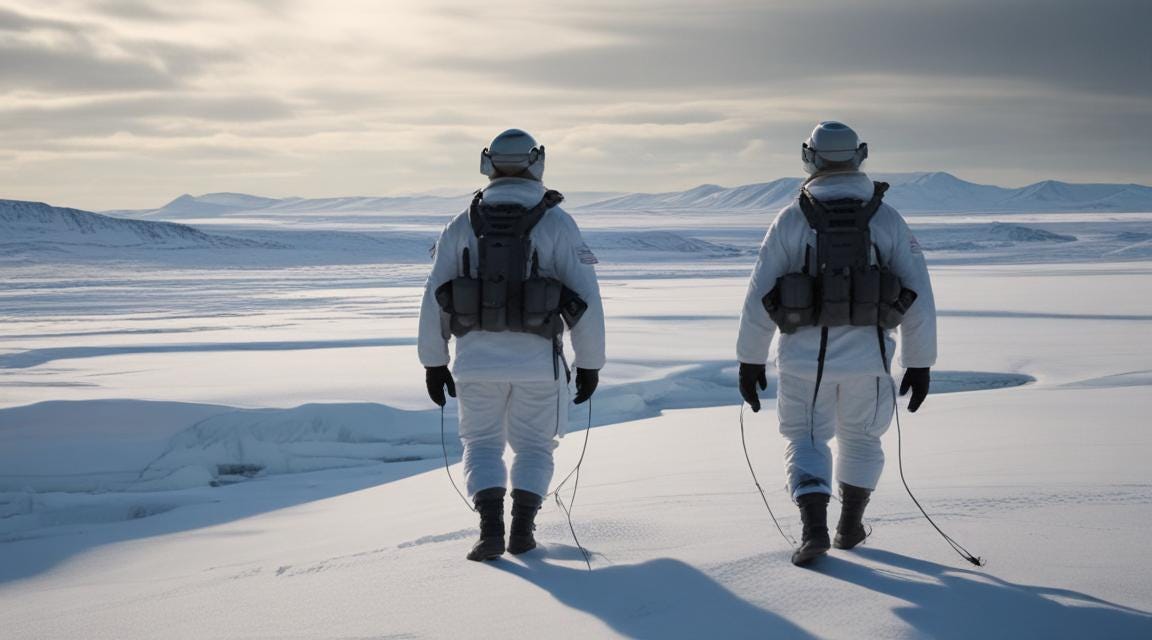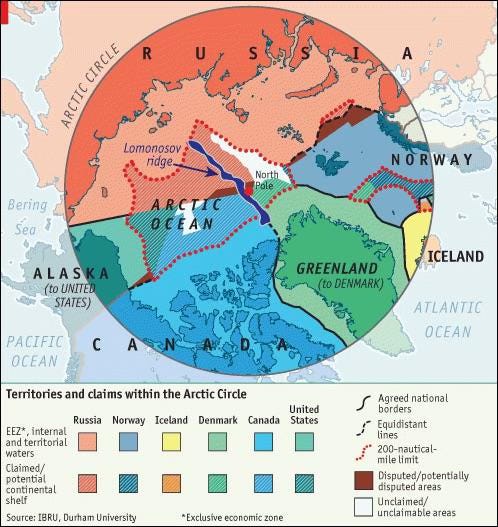Deliberation and Discussion on the Militarisation of the Arctic Circle
In the past two centuries, territorial expansion into the Arctic occurred without wars and friction, unlike expansions in the world's temperate zones.

A Brief Introduction
In the past two centuries, territorial expansion into the Arctic occurred without wars and friction, unlike expansions in the world's temperate zones. This was because the Arctic was considered to have limited economic value. However, now, due to a warmer climate, new hydrocarbon extraction technologies, and interest in northern maritime routes, a new competition is emerging in the Arctic. In 2007, Russia planted a titanium flag on the Arctic seabed, symbolizing its territorial claim by showing that its continental shelf extends to the North Pole.
This action has prompted the Arctic littoral countries (Canada, Denmark, Finland, Norway, and the US) to start subtly arming themselves. NATO has also shown interest in the region's strategic developments, which has elicited a sharp reaction from Russia. Additionally, China has developed an Arctic strategy that currently lacks military aspects but could adapt to future needs.
The situation is particularly dangerous because there are no broad political agreements or comprehensive legal structures to manage the region's development or mediate disputes over Arctic resources or sea lanes. The Arctic Council, formed in 1996 to address environmental issues, remains silent on security and territorial concerns. Additionally, not all Arctic nations are seen as equal. For example, when Arctic nations met in Ilulissat, Greenland, in 2008, only five were invited, excluding Sweden and Finland, which lack Arctic coastlines, and Iceland, which is just below the Arctic Circle but important for Arctic shipping routes. This meeting highlighted the divide between Arctic nations regarding the future of the Arctic Ocean. If tensions over Arctic resources increase, it could lead to aggressive actions by nations in the region, potentially becoming similar to the South China Sea dispute over the Spratly Islands, where multiple states claim sovereignty without a clear resolution.
The militarization of the Arctic region is an emerging reality, driven by several factors. Russia has been the most assertive in the region, establishing new military bases, forming special Arctic brigades, and expanding its fleet of nuclear-powered icebreakers, seen as a belligerent response by the West. In response, NATO countries have increased their military presence and exercises in the Arctic, with large-scale operations such as "Joint Viking" and "Joint Warrior" involving over 20,000 troops, viewed as defensive measures to counter Russia's buildup. The Arctic's strategic importance for its energy resources, trade routes, and security implications has led to growing competition for control and influence among countries like the U.S., China, and NATO members. Geopolitical tensions, particularly the Russia-Ukraine conflict, have heightened tensions between Russia and NATO, which are now playing out in the Arctic, with seven of the eight Arctic Council members being NATO allies. Despite the current discourse on Arctic militarization potentially being exaggerated, as the military capabilities of Arctic states remain limited beyond their own borders and most activities focus on domestic competencies, the introduction of military forces into the Arctic could alter regional diplomacy and cooperation. This development needs careful management to ensure the continued functioning of the Arctic regime.
NATO is playing a limited but growing role in the militarization of the Arctic region. It has been conducting large-scale military exercises, such as "Joint Viking" and "Joint Warrior," involving over 20,000 troops, seen as defensive measures against Russia's military buildup. Norway hosted NATO's largest military exercise since 2002, Trident Juncture, in 2018, highlighting its view of Russia as a major threat and the Arctic as a critical vulnerability. Some experts suggest NATO should limit its direct role in the Arctic to avoid weakening alliance unity and antagonizing Russia, focusing on contingency planning and occasional large exercises. NATO lacks an Arctic regional security strategy, and there are no multilateral forums addressing hard security issues in the Arctic. Increasing competition and militarization, particularly by Russia and China, is concerning, especially as NATO and Russia do not have a high-level military hotline for rapid de-escalation. In summary, while NATO is increasing its presence in the Arctic, its role remains limited compared to individual member states, but the region's militarization risks escalating tensions and potential miscalculations.
China is playing an increasingly assertive role in the militarization of the Arctic, though its activities are more limited compared to Russia's aggressive buildup. While NATO conducts large-scale military exercises in the Arctic to counter Russia, China's direct military presence and exercises in the region remain minimal. Experts suggest China is more likely to use international laws to conduct military activities rather than establish permanent military bases. China is developing dual-use infrastructure, such as icebreakers, research stations, and observation networks, to expand its strategic footprint under the guise of scientific research. The Russia-Ukraine conflict has heightened Arctic tensions, with China accused of aligning with Russia's interests, despite claiming the Arctic belongs to all countries. China adheres to mainstream international law in the Arctic while maintaining a more revisionist stance in its regional waters, a contradiction that could weaken its legal arguments. In summary, China is increasing its presence and capabilities in the Arctic through dual-use infrastructure and legal maneuvering, posing risks of further militarization amidst growing geopolitical tensions.
The militarization of the Arctic by China is causing significant concern among other Arctic nations. The U.S. Department of Defense and Secretary of State have publicly cast doubt on China's self-proclaimed status as a "near-Arctic state," reflecting widespread skepticism about China's true intentions and fears that it may seek to undermine the existing regional order. China's expanding military capabilities in the Arctic, including research expeditions, observation stations, and dual-use infrastructure, have alarmed Arctic states, which view these activities as potential threats to regional security. In response, NATO has been conducting large-scale military exercises in the Arctic, and individual Arctic states like Norway are bolstering their military presence and capabilities to counter the growing great power competition. The increased military activities of both China and NATO in the Arctic heighten the risks of miscalculation and unintended escalation of tensions, with experts warning that the lack of established military-to-military communication channels between China, Russia, and NATO further exacerbates these risks. In summary, China's military activities and growing presence in the Arctic are viewed with significant suspicion and concern by other Arctic nations, who see them as potential threats to regional security and are taking defensive measures, increasing the risks of miscalculation and escalation in this strategically important area.
The Reason(s)
The militarization of the Arctic region is driven by several key factors. Russia's aggressive military buildup includes establishing new bases, forming Arctic brigades, and expanding its fleet of nuclear-powered icebreakers, which the West sees as a belligerent response. NATO countries have increased their presence and exercises in the Arctic, with operations like "Joint Viking" and "Joint Warrior" involving over 20,000 troops as a countermeasure to Russia. The Arctic's strategic importance for its energy resources, trade routes, and security implications has intensified competition for control among the U.S., China, and NATO members. The Russia-Ukraine conflict has further heightened tensions between Russia and NATO, now spilling over into the Arctic, with seven of the eight Arctic Council members being NATO allies. Although the discourse on Arctic militarization may be exaggerated, as the Arctic states' military capabilities are limited beyond their borders and mostly focus on domestic competencies, the introduction of military forces could significantly alter regional diplomacy and cooperation. This needs to be carefully managed to ensure the continued functioning of the Arctic regime.
The militarization of the Arctic is driven by a mix of economic and geopolitical interests. Economically, the region's significant untapped oil and gas reserves are becoming more accessible as sea ice retreats, prompting countries to stake claims and secure these resources. The melting sea ice is also opening new shipping routes, like the Northern Sea Route along Russia's coast, which countries aim to control for economic and military purposes. Additionally, the Arctic contains valuable mineral resources, including rare earth elements, that nations are eager to exploit. Geopolitically, the Arctic is becoming a new arena for rivalry among major powers like the U.S., Russia, and China, who are building up military capabilities to project power and influence. There are unresolved territorial disputes over maritime boundaries and island ownership, leading to military posturing by nations asserting their claims. Russia, in particular, seeks to reassert its dominance in the Arctic, viewing it as a strategic backyard, and is engaging in an aggressive military buildup to deter rivals and solidify its influence. However, experts argue that the current level of militarisation is still limited compared to the Cold War era, with most activities focused on developing domestic competencies rather than preparing for outright conflict.
Despite this, the growing great power competition and lack of established military communication channels raise the risks of miscalculation and unintended escalation in the region.




